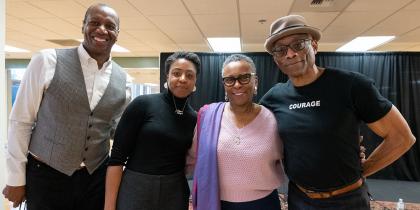You are here
Is There a We?
Ed Taylor, Lauren Flemister, Vivian Phillips, Bill T. Jones (photo by Susan Fried)
“Art happens when something is being pushed against.” – Bill T. Jones.
In Bill T. Jones’ latest work, What Problem?, the choreographer is pushing against established notions of community and examining what it means to belong—or not belong. The piece demands an answer to “What determines who belongs and who doesn’t?” What are the consequences, physical, spiritual and psychological on people who have been “othered?” Is it possible to undo the damage, and is reconciliation within a fractured community even possible?
These questions and more were raised at a town hall meeting that featured Bill T. Jones in conversation with Deputy Director at the Office of Planning & Community Development Lauren Flemister, and UW vice provost and dean of Undergraduate Academic Affairs Ed Taylor at Langston Hughes Performing Arts Institute on Tuesday, March 22.
Co-sponsored by Langston and Meany Center and moderated by arts producer and civic advocate Vivian Phillips, the convening question, “Is there a We?” resonated in very specific ways with the members of the panel and the 60 or so audience members in attendance, many of whom live in the Central District where Langston is located.
Lauren Flemister spoke with painful honesty about neighborhoods that are considered ancestral homes, but which are becoming mere memories. The Central District, she pointed out, is still thought of as where the Seattle Black community lives. “City Hall still thinks of it that way,” she said, “but the reality is that the Black population has been in decline for some time” due to gentrification. Government policy is trying to shore up what’s left, but policy is always reactive — and always too late. “It’s almost impossible to get back what’s been lost,” she said.
For Bill T. Jones, the dance company he founded with his personal and professional partner, the late Arnie Zane, was an expression of “not the world we lived in, but the world we wished to live in.” Jones is Black; Arnie was white and Jewish; both were gay. Their company included dancers across a broad spectrum of ethnicities, gender identities, sexual orientations and body types — “We were so unlike anything else at the time (the ’80s), we were considered a cult,” Jones said.
Ed Taylor recalled his time as an undergraduate at Gonzaga University — one of only five Black students in his year. It was the early ’80s and Spokane was at the epicenter of the Aryan Nation white nationalist movement. Taylor recalled “making myself invisible;” he roomed alone and stayed to himself. “For me, University was lonely and isolating,” he said.
Members of the audience contributed their own experiences to the conversation — many speaking of their feelings of isolation and othering from the communities they lived in; and many identified specific works of art as a thing that saved their lives.
More than one person pointed out that both history and current events demonstrate that community (like art) seems to happen when something is being pushed against. “It seems there are a whole list of traits that define a successful community,” Vivian Phillips remarked. “Survival, resilience, resistance, diversity — of thought, and of talent as well as ethnicity.”
Jones responded: “There’s one thing that is true of both personal relationships and communities: it won’t work unless you love a shared dream. That’s why saying ‘no’ and resisting is one way of coalescing. Look at Ukraine.”
When asked where art and artists fit into community building, Flemister said, “In the kind of work I do, art is the part of you people want you to leave behind. But we need the visionaries, the dreamers — the people who are unafraid to take big leaps.”
Jones said, “Artists are a very mixed blessing. We don’t like to be told what to do — we can be irritants to community building.”
Ed Taylor had the last word. “Artists can tell the truth,” he said. “I can’t always tell my own truth, so I look to artists to tell me theirs.”


